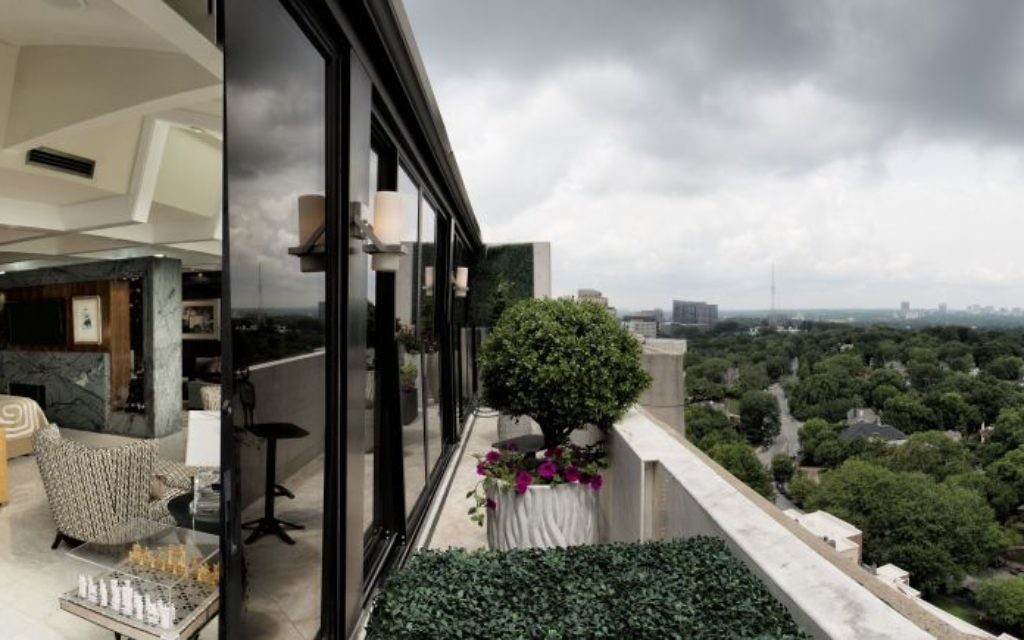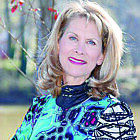Midtown Penthouse Stuns With Continental Class
Rosthema Kastin’s Midtown penthouse is a return to glamour, bracingly beautiful with a global sense of chic.

Designer Rosthema Kastin’s Midtown penthouse is a return to glamour, bracingly beautiful with a global sense of chic. She got what she wanted by downsizing from a spacious Sandy Springs home to Cabbage Patch Kids founder and folk artist Xavier Roberts’ top-floor condominium, which she gutted and renovated.
Ros, an interior designer (Rosthema Ltd., Interiors of Distinction) for high-end houses and condos from Manhattan to Miami Beach, has a certain je ne sais quoi presence that dovetails into her being an avid golfer, snow skier and grandmother, all with the flair of a duchess.
The penthouse uses floor-to-ceiling mirrors to bring the city inside.
Get The AJT Newsletter by email and never miss our top stories Free Sign Up

Ros knows her way around elegance and the execution of it.
One side’s view is downtown Atlanta. From upstairs there’s a panoramic view of Kennesaw Mountain and Buckhead to Stone Mountain.
Jaffe: You are multilingual. Share your background.
Kastin: I grew up (until adolescence) in Bucharest, Romania. My father, an OB-GYN, petitioned for 11 years before being allowed to move us to Paris (since a Communist Party official coveted our home). We emigrated from France as “necessary persons” to the U.S. because of his professional credentials.
I speak English, French and Romanian and get by in Italian and Spanish. None, however, without an accent. All of this cultural exposure influenced my sense of design and taste. The living room Tabriz carpet and the 1960 crown glass Baker cabinets were my parents’, whose home was filled with objets d’art.
Jaffe: How would you describe your style?
Kastin: I treat each project to reflect what my clients would do if they had my interior design education, my eye and experience. “Contemporary with European sensibility” is my personal style. “Contemporary” lets my imagination soar, but it’s demanding and must be precise.
Each object has its own limelight but works with the rest of the pieces. Attention to detail is crucial. I utilize every inch of space — nooks turned into hidden storage, like my hat collection in a foyer closet. I designed these light, aluminum-framed sliding doors to cordon off spaces, like hiding kitchen preparation while entertaining.
Jaffe: What were the construction logistics?
Kastin: It took two years to build. I gutted the space down to the concrete. Before I tackled furnishings, I considered what could be done architecturally.
I addressed every surface, from ceilings to walls to floors. I already had an image in mind. Husband Paul, who was ultimately supportive, shook his head until he saw it coming together.
Jaffe: He should have known to never doubt your talent. What are some of your special touches that being a designer affords?
Kastin: I wanted French lavender and coral as accents to my neutral color scheme, not the red lilac hue more readily found in fabrics. I had the fabric made by combining stripes of the French lavender in a Canovas fabric with the silvery taupe satin from Bergamo, and voila! Perfect for the Chanel quilted bench and pillows. We also have that lavender on the weeping-willow-tree, hand-painted silk wall covering hugging the glass-and-steel staircase.

Lacquered panels on the support columns have grid lines that mimic the surrounding buildings’ architecture. The open plan’s transparency and reflective surfaces provide fluidity.
Jaffe: You have a specific approach to textures and surfaces.
Kastin: I use unusual materials for their interplay. The glass elevator and stairs open things up. I love Makassar ebony wood from South America for its rich color and subtle pattern. Onyx surrounds the fireplace. Malachite, Murano glass, jade and antique cloisonné all have their place.
The most unusual natural material is the dark-green, tactile, African soapstone with light-green inclusions enclosing the ribbon fireplace and see-through room divider between the master suite and the library. Perhaps Mother Nature is the best designer.
Jaffe: How do you express your love of photography?
Kastin: That’s a full question. My favorites (all black and white) are Elliott Erwitt, a Jewish photographer, who condensed the action in the car’s side-view mirror in “California Kiss.” I pass by it every morning, and it makes me smile. Frank Horvat shot these high heels. … The details are in the triangles (1974’s “Paris, Shoes and Eiffel Tower A”).
Another favorite is Man Ray’s (Emmanuel Radnitzky, also Jewish) “Le Mannequin.”
Larger is the very emotional Susan Derges photograph.
Her face occupies the entire field, as viewed from a distance. Closer, her large portrait recedes, and her face reappears within drops of water strung like a necklace.
Jaffe: Your master suite is the entire top floor.
Kastin: The south end is the office, with the telescope by a primary-colored, surrealistic diptych. The library is on the north wing. We wake up to the beautiful view and have coffee at the morning bar with Mozambique wood paneling. Matching Indian ivory tiled dogs sit atop cabinets, and a mysterious oil of three Bukharan men was purchased while in central Asia.
Jaffe: Who are your favorite artists?
Kastin: The Picasso (“Jacqueline dans son Atelier,” 1956) and Chagall (“Sirene a L’Epine”) — they may be the most famous names but not necessarily my very favorite. I love sculpture. When my husband went on a golf trip, I flew to Paris to meet Philippe Hiquily and acquired “La Gifle,” which we purchased over drinks at the hotel bar. Upstairs is a brass sculpture (Carbonell) of a seated woman, torso bending to frame a view of a church steeple.
Jaffe: What are some of your most unusual pieces?
Kastin: All have a story. The spectacular crystal 1850 Osler English dining room chandelier. The D’Ore French clock, Louis XVI, on a Charles X base with marquetry design. I found this 17th century Venetian mirror covered in dust in a New Orleans gallery. The Khmer warrior terra cotta bust is stoic.
Jaffe: Last word — you’re a city gal.
Kastin: Give me concrete, bright lights, traffic, buildings, energy and urban activity, and I’m happy!
Photos by Duane Stork






comments